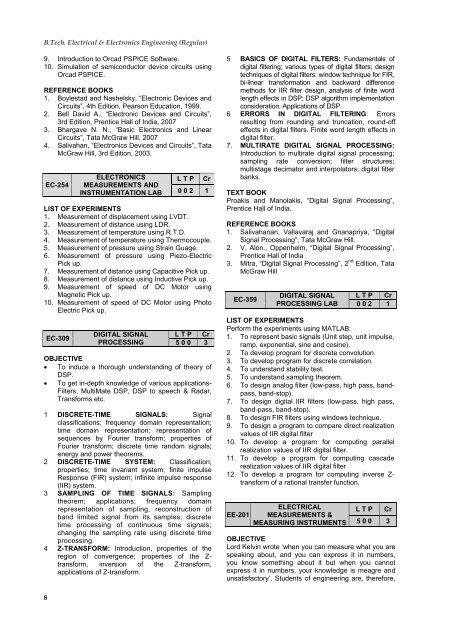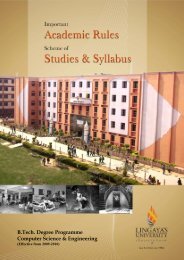B.Tech. <strong>Electrical</strong> & <strong>Electronics</strong> Engineering (Regular)9. Introduction to Orcad PSPICE Software.10. Simulation of semiconductor device circuits usingOrcad PSPICE.REFERENCE BOOKS1. Boylestad <strong>and</strong> Nashelsky, ―Electronic Devices <strong>and</strong>Circuits‖, 4th Edition, Pearson Education, 1999.2. Bell David A., ―Electronic Devices <strong>and</strong> Circuits‖,3rd Edition, Prentice Hall of India, 20073. Bhargave N. N., ―Basic <strong>Electronics</strong> <strong>and</strong> LinearCircuits‖, Tata McGraw Hill, 20074. Salivahan, ―<strong>Electronics</strong> Devices <strong>and</strong> Circuits‖, TataMcGraw Hill, 3rd Edition, 2003.EC-254ELECTRONICSMEASUREMENTS ANDINSTRUMENTATION LABL T PCr0 0 2 1LIST OF EXPERIMENTS1. Measurement of displacement using LVDT.2. Measurement of distance using LDR.3. Measurement of temperature using R.T.D.4. Measurement of temperature using Thermocouple.5. Measurement of pressure using Strain Guage.6. Measurement of pressure using Piezo-ElectricPick up.7. Measurement of distance using Capacitive Pick up.8. Measurement of distance using Inductive Pick up.9. Measurement of speed of DC Motor usingMagnetic Pick up.10. Measurement of speed of DC Motor using PhotoElectric Pick up.EC-309DIGITAL SIGNALPROCESSINGL T P Cr5 0 0 3OBJECTIVE To induce a thorough underst<strong>and</strong>ing of theory ofDSP. To get in-depth knowledge of various applications-Filters, MultiMate DSP, DSP to speech & Radar,Transforms etc.1 DISCRETE-TIME SIGNALS: Signalclassifications; frequency domain representation;time domain representation; representation ofsequences by Fourier transform; properties ofFourier transform; discrete time r<strong>and</strong>om signals;energy <strong>and</strong> power theorems.2 DISCRETE-TIME SYSTEM: Classification;properties; time invariant system; finite impulseResponse (FIR) system; infinite impulse response(IIR) system.3 SAMPLING OF TIME SIGNALS: Samplingtheorem; applications; frequency domainrepresentation of sampling, reconstruction ofb<strong>and</strong> limited signal from its samples; discretetime processing of continuous time signals;changing the sampling rate using discrete timeprocessing.4 Z-TRANSFORM: Introduction, properties of theregion of convergence; properties of the Z-transform, inversion of the Z-transform,applications of Z-transform.5 BASICS OF DIGITAL FILTERS: Fundamentals ofdigital filtering; various types of digital filters; designtechniques of digital filters: window technique for FIR,bi-linear transformation <strong>and</strong> backward differencemethods for IIR filter design, analysis of finite wordlength effects in DSP; DSP algorithm implementationconsideration. Applications of DSP.6 ERRORS IN DIGITAL FILTERING: Errorsresulting from rounding <strong>and</strong> truncation, round-offeffects in digital filters. Finite word length effects indigital filter.7. MULTIRATE DIGITAL SIGNAL PROCESSING:Introduction to multirate digital signal processing;sampling rate conversion; filter structures;multistage decimator <strong>and</strong> interpolators; digital filterbanks.TEXT BOOKProakis <strong>and</strong> Manolakis, ―Digital Signal Processing‖,Prentice Hall of India.REFERENCE BOOKS1. Salivahanan, Vallavaraj <strong>and</strong> Gnanapriya, ―DigitalSignal Processing‖, Tata McGraw Hill.2. V. Alon., Oppenhelm, ―Digital Signal Processing‖,Prentice Hall of India3. Mitra, ―Digital Signal Processing‖, 2 nd Edition, TataMcGraw HillEC-359DIGITAL SIGNALPROCESSING LABL T P Cr0 0 2 1LIST OF EXPERIMENTSPerform the experiments using MATLAB:1. To represent basic signals (Unit step, unit impulse,ramp, exponential, sine <strong>and</strong> cosine).2. To develop program for discrete convolution.3. To develop program for discrete correlation.4. To underst<strong>and</strong> stability test.5. To underst<strong>and</strong> sampling theorem.6. To design analog filter (low-pass, high pass, b<strong>and</strong>pass,b<strong>and</strong>-stop).7. To design digital IIR filters (low-pass, high pass,b<strong>and</strong>-pass, b<strong>and</strong>-stop).8. To design FIR filters using windows technique.9. To design a program to compare direct realizationvalues of IIR digital filter10. To develop a program for computing parallelrealization values of IIR digital filter.11. To develop a program for computing cascaderealization values of IIR digital filter12. To develop a program for computing inverse Z-transform of a rational transfer function.EE-201ELECTRICALMEASUREMENTS &MEASURING INSTRUMENTSL T PCr5 0 0 3OBJECTIVELord Kelvin wrote ‗when you can measure what you arespeaking about, <strong>and</strong> you can express it in numbers,you know something about it but when you cannotexpress it in numbers, your knowledge is meagre <strong>and</strong>unsatisfactory‘. Students of engineering are, therefore,8
Lingaya’s <strong>University</strong>, Faridabadcalled upon to learn the rudiments of measurementsvery early in their study period.1. UNITS, STANDARDS & MEASUREMENTERROR: S. I. Units; accuracy & precision; error &correction; significant figures; types of errors –gross, systematic& r<strong>and</strong>om; types of st<strong>and</strong>ards;constructional aspects (only general features) ofprimary st<strong>and</strong>ards; absolute determination ofresistance; resistance st<strong>and</strong>ards; primary <strong>and</strong>laboratory st<strong>and</strong>ards of e.m.f.2. MEASURING SYSTEM FUNDAMENTALS: Thegeneralized instrumentation system block diagram &description of blocks; classification of Instruments(Absolute & Secondary Instruments); Indicating,Recording & Integrating instruments (Based uponPrinciple of operation); three forces inelectromechanical indicating instrument (Deflecting,controlling & damping forces), Comparison betweengravity & spring controls; comparison of dampingmethods & their suitability; bearing supports, pivotlesssupports (Simple & taut-b<strong>and</strong>); Scaleinformation; Instrument cases (Covers).3. MEASURING INSTRUMENTS: Galvanometers – D‗Arsonval, ballistic <strong>and</strong> vibration galvanometers,construction <strong>and</strong> theory; Ammeter <strong>and</strong> Voltmeters –general constructional features, operating principle,torque equation, shape of scale; advantages <strong>and</strong>disadvantages of PMMC type, electro dynamic type,moving iron type (attraction & repulsion), inductiontype <strong>and</strong> rectifier type instruments; errors (both onAC/DC type); extension of instrument range – shunts<strong>and</strong> multirange ammeters, voltmeter multipliers;potential divider arrangement; sensitivity; multimeters.4. MEASUREMENT OF POWER AND ENERGY:Electro dynometers type wattmeter; low powerfactor wattmeter; reactive power measurements;induction type energy meter – construction, theory,errors <strong>and</strong> adjustments, calibration.5. MEASUREMENT OF RESISTANCE,INDUCTANCE AND CAPACITANCE: Wheatstonebridge; limitations; sensitivity analysis; Kelvin‘sdouble bridge; earth resistance measurement;measurement of insulation resistance; a st<strong>and</strong>ardinductor; frequency error in inductance <strong>and</strong>capacitor; general considerations of inductance<strong>and</strong> capacitance comparison bridges; Andersonbridge; Hay‘s bridge; Wein‘s bridge; Scheringbridge; detectors used in A.C. bridges; errors inbridge measurements <strong>and</strong> precautions to be takenin minimizing errors or eliminations; Wagner‘searthing device <strong>and</strong> shielding.6. INSTRUMENTS TRANSFORMERS: Current <strong>and</strong>potential transformers; ratio <strong>and</strong> phase angleerrors; construction, theory; use of instrumenttransformers for measurement of power.7. MAGNETIC MEASUREMENTS: Construction &working of Flux meter; determination of B-H Curve<strong>and</strong> hysteresis loop. Determination of iron lossesby Lloyd Fisher Square; separation of iron losses.TEXT BOOKSawhney, A. K., ―A Course in <strong>Electrical</strong> <strong>and</strong> ElectronicMeasurements & Instrumentation‖, Dhanpat Rai &Sons, New Delhi, 2009.REFERENCE BOOKS1. An<strong>and</strong>, M.M.S., ―Electronic Instruments <strong>and</strong>Instrumentation Technology‖, Prentice-Hall ofIndia, Pvt. Ltd. 2005.2. Northrop, Robert B, ―Introduction toInstrumentation <strong>and</strong> Measurements‖, 2 nd Edition,CRC Press, Taylor & Francis Group Special IndianEdition, 2008.3. Helfric A. D. & Cooper W. D., ―Modern ElectricInstrumentation & Measuring Instruments‖,Prentice Hall of India, 2003.4. Golding, E. W. & Widdis F. C., ―<strong>Electrical</strong>Measuring Instruments & Measurements‖, WheelerPublishing Company.EE-202ELECTRICAL NETWORKTHEORYL T P Cr5 0 0 3OBJECTIVESElectric networks make up an inseparable part of theelectric gadgets <strong>and</strong> equipment of modern –day living.An electric system without network is un-imaginable.This subject provides an in-depth underst<strong>and</strong>ing of thetheoretical concepts <strong>and</strong> practical applications ofcircuits <strong>and</strong> their analysis – which are very essential tograsp the fundamentals of other disciplines ofengineering such as communications, power systems<strong>and</strong> computer etc.1. NETWORK ANALYSIS: Independent <strong>and</strong>dependent voltage <strong>and</strong> current sources; circuitanalysis with independent & dependentsources – Mesh current <strong>and</strong> node voltageanalysis, Thevinin‘s <strong>and</strong> Norton‘s theorems;maximum power transfer theorem & impedancematching; superposition principle; Tellegen‘stheorem; network graphs <strong>and</strong> definitions;branch to node incidence matrix; reducedincidence matrix; branch to loop incidencematrix; cut set matrix; Kirchhoff‘s laws; networkequilibrium equations.2. POLYPHASE SYSTEMS: Double-subscriptnotation; phase sequence; voltage relations inbalanced – Wye system <strong>and</strong> delta systems; currentrelations in Wye <strong>and</strong> delta systems; current in theneutral of unbalanced Wye systems; Unbalanced3-wire, <strong>and</strong> 4-wire Wye-Wye systems; Unbalanceddelta systems – fixed voltages assumed at the loadterminals; combination of single – phase along withbalanced three phase loads; problem of neutralshift; residential circuits wiring.3. TRANSIENT RESPONSE: Capacitive transients –v-i relationships; circuit model of chargedcapacitor, capacitive power, energy, stored incapacitance; Inductive transients – v-irelationships, circuit model of fluxed inductor,inductive power, energy stored in inductance;comparison of capacitive <strong>and</strong> inductive v-irelationships; transient response of RC, RL, RLCcircuits to various excitation signals such as step,impulse <strong>and</strong> sinusoidal excitations using LaplaceTransform.4. TWO PORT NETWORKS: Type of problems;representation of networks; two port networkparameters –short circuit admittance, open circuitimpedance, ABCD, transmission <strong>and</strong> hybridparameters; relationship between parameter sets;9
















